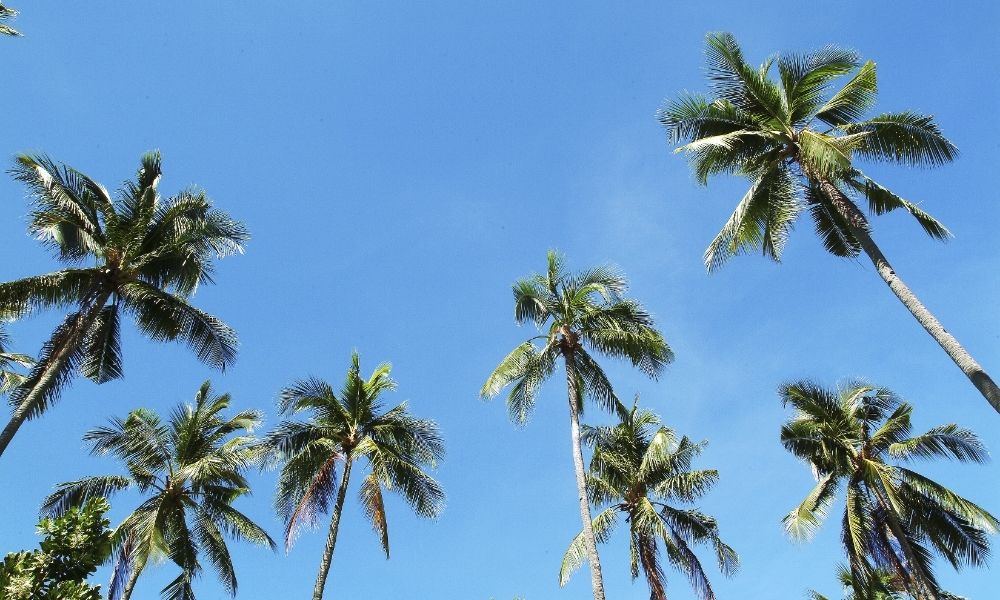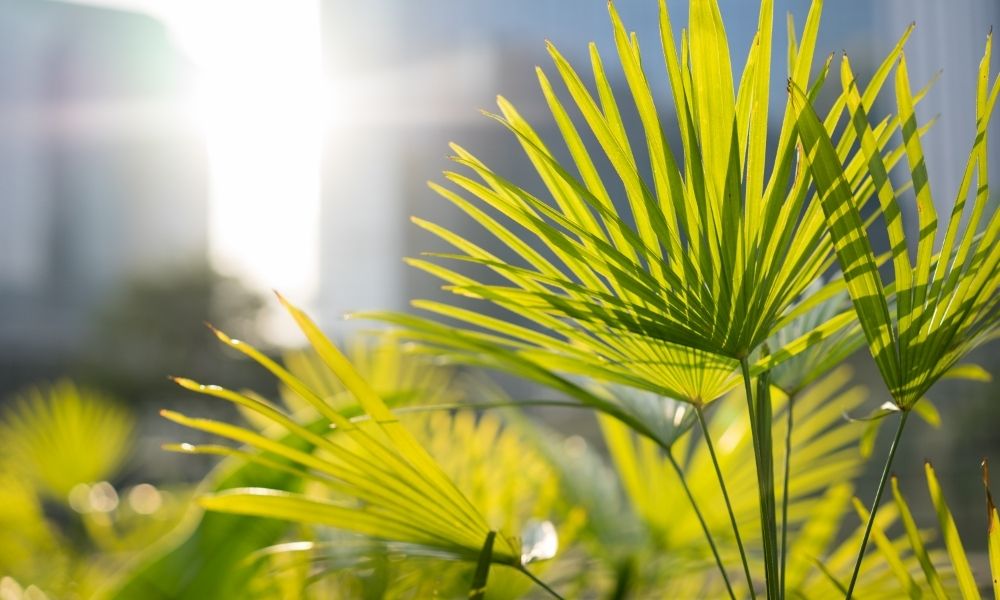
Types of Palm Trees to Decorate Your Indoor and Outdoor Spaces
Palm trees are known for their exotic tropical look and elegance. They are the perfect decorative addition for your interior aesthetics or outdoor gardens. There are many types of palm trees you can choose from to decorate your home.
They come in many shapes, colors, and sizes, and there are more than three thousand species in the world. This blog will discuss the types of palm trees and their categories and the basic things you need to know to choose the perfect tree for your property.
Top Categories and Types of Palm Trees
These are our top types of palm trees and their categories:
- Small Palm Trees
- Cold Hardy Palm Trees
- Palm Trees with Edible Fruits
- Fast Growing Palm Trees
- Highly Salt Tolerant Palm Trees
- Indoor Palm Trees
- High Drought Tolerant Palm Trees
Small Palm Trees

Palm trees grow from a single trunk and are a versatile, elegant option for your yard. They are also known as miniature or dwarf palm trees and usually grow up to 20 feet tall. You can plant them on your property without any risk of causing any damage to the foundation.
Below, you will find two examples for small palm trees:
Sago Palm (Cycas revoluta)
Sago palm is a feathery foliage houseplant, perfect for any room. Although they are classified as palm trees, they belong to the cycad family, hence the plant’s hardiness.
They are also easy to care for; however, they require special attention, such as being placed in well-drained soil and bright light. Therefore, every time they’re watered, it’s best to allow them to dry before the next water round.
Bottle Palm (Hyophorbe lagenicaulis)
Bottle palm trees are Mascarene Island native trees and get their name from the shape of their trunk. These palms grow slowly and reach up to 15 feet tall. And its swollen trunk is full of arched dark leaves.
They thrive in full sun and are salt-tolerant. On the other hand, they can suffer damage in cold temperatures. Due to their unusual shape, bottle palms are great focal points for every landscape.
Indoor Palm Trees

Indoor palm trees thrive in warmer temperatures and average humidity. They adapt pretty well to containers and large pots and make a statement in every room.
They adapt to a wide range of soils, making them perfect for indoor environments. Here are two of the most popular indoor palm trees.
Areca Palm (Chrysalidocarpus lutescens)
They are one of the most popular indoor palm trees. It grows around 7 inches per year and has long, bright green feather-shaped fronds. It thrives in indirect light and requires lots of water and well-drained soil.
Ponytail Palm (Beaucarnea recurvata)
Ponytail palm is one of the most forgiving indoor palms. It is also known as Elephant-foot tree, Monja, and Palma culona. It grows up to 6 feet tall and can tolerate low-level lights.
Cold Hardy Palm Trees

There is a wide variety of palm trees that can thrive in cold weather. Cold hardy palm trees can tolerate temperatures below 15 degrees. Below you can find some palm trees you can plant in regions with lower temperatures.
Chinese Fan Palm (Livistona Chinensis)
This palm is native to China and Japan. Its name comes from the fan-shaped, green leaves that look like an open fan. Chinese fan palm is frost tolerant and thrives in a wide temperature range.
Sabal Palm (Sabal palmetto)
This palm is the state tree of South Carolina and Florida. It is also known as cabbage palm and can tolerate temperatures up to 5 degrees and grows up to 30 feet tall.
Palm Trees With Edible Fruits

The edible fruit of palms is beneficial for regulating sugar levels, kidney stones, avoid constipation, and more. Among these trees, we can find coconut, date, açai, and other fruits.
Coconut Palm (Cocos nucifera)
Coconut palms can live up to 80 years in the right conditions. They can quickly grow up to 80 feet tall and are known for producing sweet, watery coconuts. These palms bear fruits throughout seasons and can produce up to 200 coconuts per year.
True Date Palms (Phoenix dactylifera)
These palms bear sweet, tasteful dates. True date palm thrives in any soil and hails from North Africa. Its fruits are used to produce syrups, drinks, ice cream, and others.
Fast Growing Palm Trees

Many landscape contractors save money and time by getting fast-growing palm trees to achieve the desired landscape style. Several palms provide shade and sun protection. Here are two fast-growing palms:
Foxtail Palm (Wodyetia Bifurcata)
Foxtail palm is becoming one of the most popular palm trees for landscaping projects. They grow fast and can reach up to 30 feet tall. It is pretty adaptable to soil conditions and thrives in full sun.
Queen Palm (Syagrus Romanzoffiana)
These fast-growing palm trees love the full sun and are rarely bothered by diseases and pests. Queen palms have a growing rate of 3.5 feet per year, reaching a mature size of 25 feet.
Highly Salt Tolerant Palm Trees

Coastal land growing palms are highly salt-tolerant and are an excellent choice for your landscape if you are near the water.
Spindle Palm (Hyophorbe verschaffeltii)
These palms are pretty similar to bottle palms due to their swollen trunk. However, they grow slightly taller and stiffer. They adapt quickly to a wide range of soil conditions and are highly salt tolerant.
Buccaneer Palm (Pseudophoenix sargentii)
It is one of the most durable salt-tolerant palm trees. You can also know it as Cherry Palm or Palma de Guinea. Generally, these palms are problem-free and drought. Great for growing in zone 10b-11.
High Drought Tolerant Palm Trees

Native desert palms are one of the most drought tolerant due to their adaptability to dry soils. However, it depends on many factors, as humidity levels, wind conditions, sun exposure, and others.
On the other hand, newly planted trees need constant watering to survive the first months, even if they’re drought tolerant.
Triangle Palm (Dypsis Decaryi)
Triangle palms are unique due to their peculiar trunk triangular shape. Adding this palm to your landscape will provide a sense of tropic and, best of all, low cost.
Choose the Perfect Palm Tree
Now that you know the different categories and types of palm trees, you can choose the right palm tree for your landscape. If you want to avoid performing maintenance tasks as trimming or pruning, give us a call, and we will help you out.



